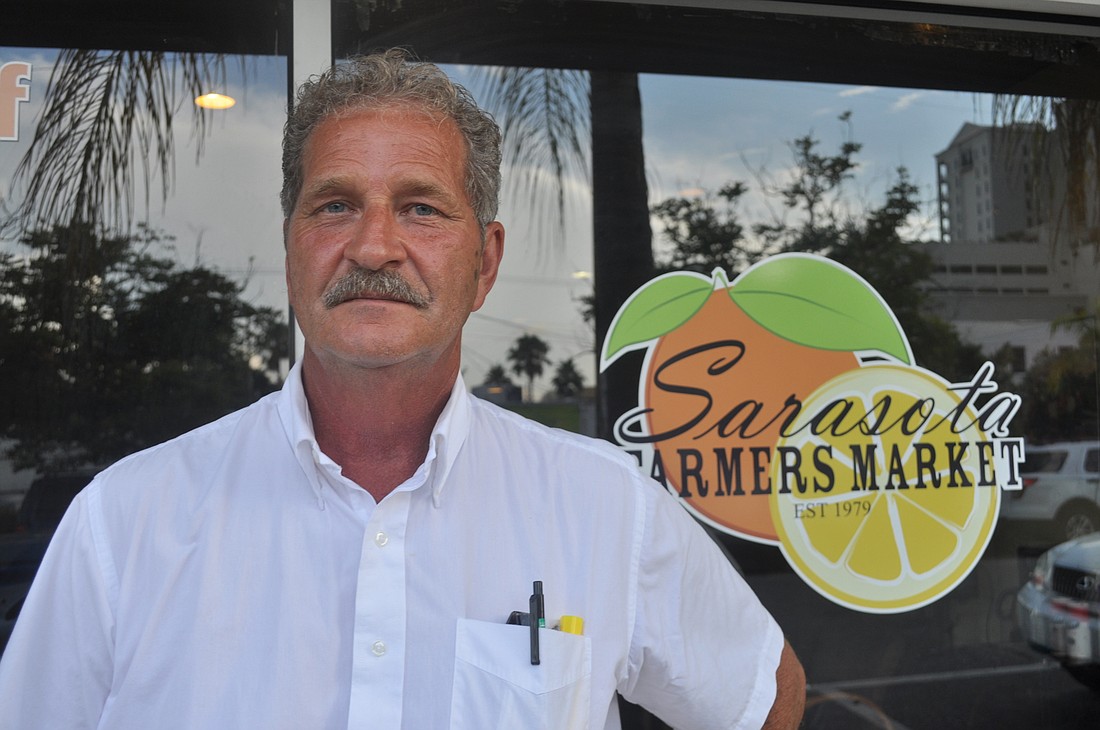- April 27, 2024
-
-
Loading

Loading

As manager of the Sarasota Farmers Market, Phil Pagano has growth on his mind. Thanks to the success of the event — which can bring in more than 12,000 people on Saturdays during the height of season and recently underwent a trial expansion to Wednesdays — Pagano is contemplating how the farmers market will look in the future.
The organization running the market has existed in its current form for six years, but the downtown market has been in place since 1979. Pagano is focused on developing a roadmap for the market as it continues to grow, including the potential purchase of a permanent home. On Tuesday, Pagano hosted a “vision meeting” to begin discussing the future of the market with vendors and customers. We spoke to him after that meeting to get more insight:
Q: When did the thought process that led to this discussion of the future of the farmers market begin?
A: Over the years, I thought we needed a facility or something like that — a place to hang our hat, so to speak. Once I saw the (State Street garage) liner building being put up and a piece in Pineapple Park being sold, I thought to myself: We need to be more on the ball when things become available. We’re a 6-year-old organization, not-for-profit, and everybody has worked pretty hard to get to this point. I think our next step, our future, is to work on our future.
Q: When you first got involved with the market, did you foresee this growth?
A: This started on Lemon, from First Street to Lemon, with, like, 30 vendors. It’s grown over coming on 36 years to over 80, 90 vendors, with multiple spots to take up two or three blocks. We have people coming from all over the world here, especially during season.
Q: What signs show that there’s still more room for the market to grow?
A: People are in tune to markets now — buying local, buying healthy products, local growers, goods that are made by some of these vendors. I think it’s a great trend that’s happening.
Q: How did the trial run of a Wednesday market go?
A: Our turnout went OK. We could use some more customers. We had some challenges with the weather and some different things that obviously outdoor markets have to deal with. I found some people coming during season saying, “Hey, it was hard to get there on Saturday; there were so many people. This is a great outlet.” Omega Cure, Suncoast Flowers — they did pretty well, because people couldn’t get to them on Saturday.
Q: Are you looking at other cities and markets as models?
A: I think you’ve always got to look at other markets. (Local architect) Bryan Easter gave a nice presentation of other designs from around the country — it’s great hearing other people’s models. The Farmery (a concept farm, market and café in Durham, N.C.) is my favorite.
The Farmery really caught my eye. I envisioned some little slots for some vendors at the bottom, with some offices and restrooms, which we’re struggling with. And then also, you could maybe have a community room on the second floor. The Farmery actually has a rooftop garden on top of it. You could have food demos, and other organizations could use the room.
Q: Have there been times in the past in which you’ve explored securing permanent space?
A: There was a group of business folks around 2010 that had an idea of putting it under the (State Street) garage. My thought was —No. 1, they never came to us to ask us what we thought. No. 2, I thought that was going to be structured for bigger businesses. It wasn’t going to be that mom and pop; it didn’t have the taste of what we have now.
Q: How do you keep the community involved as the conversation regarding the future of the market continues?
A: The market is a big part of the community. The market is just like a post office or some of these other places where folks used to go and chat and find out what they did for the week or what they did during the day. It’s developed even more of a community atmosphere each week. Everybody just enjoys being there. Where can you go where it’s family-oriented, there are things for kids and it’s based on a lot of healthy eating?
Q: Now that season is over, what’s on the horizon for the market?
A: We’re open until 1 p.m. all year now. It’s unbelievable, even with the construction, the amount of people we’re getting. Our Shrimp and Lobster Festival is coming up June 27. That’s big. We probably bring in 8,000 to 10,000 people even in the summertime. People who live locally, they’ll come out. It’ll be warm, but they know how to deal with it.